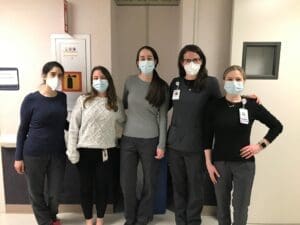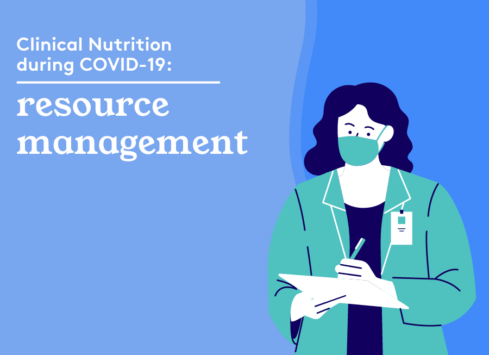Clinical Nutrition during COVID-19: Resource Management
COVID-19 has been difficult for healthcare providers across the globe. Through the difficulties of the past year, we have seen the growth of innovation and heroes. Dietitians play a crucial role in the health of our patients, especially during a pandemic. In a two-part series, we take a look at Clinical Nutrition to see the challenges and successes from their perspective. We begin our discussion with resource management.
Like families around the country, the healthcare industry has been irreparably altered by COVID-19. New challenges have presented themselves, and hospitals have scrambled to solve problems while still providing care for their communities. It has not been an easy journey, and it is a situation that continues to evolve. Within this tumultuous year, there have been stories about healthcare professionals rising to the challenge and finding ways to provide life-saving patient care.
Dietitians lie at the heart of this battle. Their jobs have shifted, and they have been asked to do more with less, particularly when it comes to material resources. The pandemic led to shortages in feeding equipment, PPE, and other materials used to treat the disease as hospitals around the country stockpiled supplies or could not secure enough of many common items. As a result, dietitians found themselves in a new place. Always important to patient wellness, they have used new skills and strategies to help patients recover from COVID-19 and they have done it through resilience, persistence and innovation.
Clinical Nutrition and Inventory Management
Julia Oblein has a long history in nutrition services. She began her career intending to work on the sports nutrition side of the business, but she transitioned to healthcare where she found passion for helping patients. At Bon Secours Maryview Medical Center in Portsmouth, Va., Oblein leads a team of dietitians at the 200-bed hospital.
When COVID-19 first arrived in the U.S., she and her team knew they had to act—and act quickly.
“When the pandemic first started, there were lots of shortages in all areas of healthcare,” Oblein said. “PPE was the initial concern for most hospitals. They had to make sure our staff was properly outfitted. We also saw shortages that played a major impact on enteral nutrition support.”
Almost immediately, they began working with the Materials Management Department to adjust inventory levels. COVID-19 led to more patients being placed on ventilators and, as a result, the increased use of tube feeding. That made stocking up on tube feeding formula a concern. Oblein increased the facility’s inventory of formula to make sure they had what their patients needed, in the event of shortages.

This type of planning can be expensive for a hospital, but it can also be a major factor in having the resources to provide patient care.
“It was key for us to collaborate across departments and make sure we had facility support, particularly with hospital administration. They needed to know what we were doing and why, so they could prepare financially as a result of additional expenses.”
The results speak for themselves. Oblein and her team have been properly resourced to care for patients. Collaboration across the care continuum and partnering with other departments allowed the hospital to make quick strategic financial decisions and secure the resources they needed for their patients.
“I’m proud of how we supported our staff and made sure the clinical nutrition team had what they needed,” Oblein said. “We were clear on the expectations for the entire team and made sure everyone was comfortable working at the highest level, even during this difficult time.”
Providing Nutrition Through Feeding Tube Pumps
For the past 16 years, Rebecca Mace has cared for patients as a dietitian for Morrison Healthcare, most recently at two hospitals in South Florida—Florida Medical Center and North Shore Medical Center.
“The virus took over everything,” Mace said. “Once the pandemic hit the state, we stopped what we were doing and turned our focus to keeping staff and patients safe.”
There were numerous challenges along the way for Mace and her team, including staffing. On the materials management side, the hospital ran out of their preferred tube feeding formula and worked directly with the manufacturer to find supplies. But the largest challenge came from feeding tube pumps.
Like much of the country, COVID-19 led to increased ICU volumes and the need for additional ventilators. While the need for ventilators may have received national headlines, there has been less coverage of supplemental equipment needed by clinical nutrition—feeding tube pumps. Due to limited supplies nationally, the hospitals could not get additional pumps, requiring Mace to get creative.
“As the situation began to unfold, we realized that we would eventually run out of pumps. We explored alternative feeding methods and found that we could utilize a gravity tube set, which would allow patients to get the nutrition they need without relying on pumps.”
The gravity tube set is more labor-intensive, requiring nursing or clinical nutrition to count the number of drips entering the patient’s feeding tube. Through that, clinical nutrition can calculate the number of calories the patient has received and administer the correct feeding. While more difficult from a care standpoint, this method proved to be an important tool when the pumps ran out.
They also utilized the bolus tube feeding method, which can be used for patients who tolerate a higher volume of nutrition. It is easier on nursing since it does not require the counting of drips, but it is not for every patient.
“We had to adjust and find what was right for the patient,” Mace said. “It took a lot of planning and training, but our teams rose to the challenge. We were there every day for the patients and for each other.”
It took ingenuity and innovation to deliver excellent patient care. COVID-19 has forced clinical nutrition to adjust, and dietitians have responded. By putting the patient first, clinical nutrition has provided lifesaving care amid shortages and extraordinary challenges.
Look for the second piece in our two-part series, which will be published next week.

